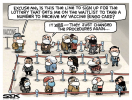Navigation
Install the app
How to install the app on iOS
Follow along with the video below to see how to install our site as a web app on your home screen.
Note: This feature may not be available in some browsers.
More options
Style variation
Guest viewing is limited
- You have a limited number of page views remaining
- 8 guest views remaining
- Register now to remove this limitation
- Already a member? Click here to login
You are using an out of date browser. It may not display this or other websites correctly.
You should upgrade or use an alternative browser.
You should upgrade or use an alternative browser.
Can touching a barbell in the gym get you sick with the coronavirus?
- Thread starter Michael Scally MD
- Start date
View: https://twitter.com/KatherineJWu/status/1356634359994974212?s=20
Side effects are a natural part of the vaccination process, as my colleague Sarah Zhang has written. Not everyone will experience them. But the two COVID-19 vaccines cleared for emergency use in the United States, made by Pfizer/BioNTech and Moderna, already have reputations for raising the hackles of the immune system: In both companies’ clinical trials, at least a third of the volunteers ended up with symptoms such as headaches and fatigue; fevers like my husband’s were less common.
Dose No. 2 is more likely to pack a punch—in large part because the effects of the second shot build iteratively on the first. My husband, who’s a neurologist at Yale New Haven Hospital, is one of many who had a worse experience with his second shot than his first.
But much like any other learning process, in this one repetition is key. When hit with the second injection, the immune system recognizes the onslaught, and starts to take it even more seriously. The body’s encore act, uncomfortable though it might be, is evidence that the immune system is solidifying its defenses against the virus.
“By the second vaccine, it’s already amped up and ready to go,” Jasmine Marcelin, an infectious-disease physician at the University of Nebraska Medical Center, told me. Fortunately, side effects resolve quickly, whereas COVID-19 can bring on debilitating, months-long symptoms and has killed more than 2 million people.
…
The provocative nature of mRNA might help explain why Moderna’s shot, which contains three times as much of the genetic material as Pfizer’s, was linked to more side effects in clinical trials.
View: https://twitter.com/michaelscally/status/1357309479050752001?s=20
On its face, the curve of COVID-19 infections in Denmark looks reassuring enough. A nationwide lockdown has led numbers to plummet from more than 3000 daily cases in mid-December 2020 to just a few hundred now. But don’t be fooled. “Sure, the numbers look nice,” says Camilla Holten Møller of the Statens Serum Institute, who heads a group of experts modeling the epidemic. “But if we look at our models, this is the calm before the storm.”
That’s because the graph really reflects two epidemics: one, shrinking fast, that’s caused by older variants of SARS-CoV-2, and a smaller, slowly growing outbreak of B.1.1.7, the variant first recognized in England and now driving a big third wave of the pandemic there. If B.1.1.7 keeps spreading at the same pace in Denmark, it will become the dominant variant later this month and cause the overall number of cases to rise again, despite the lockdown, Holten Møller says. “It is a complete game changer.”
The same is likely happening in many countries without being noticed. But a massive virus-sequencing effort has allowed Denmark, a country of 5.8 million, to track the rise of the new COVID-19 variant more closely than any other country. “All eyes are on Denmark right now,” says Kristian Andersen, an infectious diseases researcher at Scripps Research who is advising the Danish government. “When it comes to B.1.1.7, is there a way in which … we can prevent the kind of calamity that we have seen in the U.K. and Ireland, for example?” he asks.
The data aren’t reassuring. Danish scientists’ best guess is that B.1.1.7 spreads 1.55 times faster than previous variants, Holten Møller says. To keep it from spiraling out of control, the country will have to remain in lockdown—or even add new control measures—until a large part of the population has been vaccinated. That prospect is so unappealing that some epidemiologists say Denmark should consider an alternative: Reopen once the most vulnerable people are vaccinated, even if that means a big new surge in cases.
View: https://twitter.com/equitylist/status/1357315436182986757?s=20
Plenty, according to the latest independent panel report.
The mandate of the Independent Panel for Pandemic Preparedness and Response is to “provide an evidence-based path for the future, grounded in lessons of the present and the past to ensure countries and global institutions, including specifically WHO, effectively address health threats.”
These lessons are starting to emerge with the publication of the panel’s second progress report. Unsurprisingly, the report touches several key problems in the global governance of covid-19: WHO’s position, structure, and lack of financing; excessive focus on metrics to the detriment of political analysis; a lack of coordinated and sufficient financing for pandemic preparedness and response; global vaccine inequities; and the role of the broader global health architecture.
Almost every section of the report points to the extent to which politics has driven the trajectory of the pandemic in different locations—establishing that the policies chosen by governments reflect deeper political agendas and that the tension between the economy and public heath is a false dichotomy. Those governments willing to take the political and economic hit of harsh restrictions early in 2020 are now benefiting from freedom from population restrictions, and in the case of South Korea and China, flourishing economies.
Trying to appease both public health demands and the libertarian views of the free market has led not only to astronomical death tolls, such as in the US, UK, and Brazil, but to flailing economies. Halfway compromises do not work in response to pandemics and have just dragged out the pandemic for all. Frustratingly, for those of us who research the politics of global health security, this was entirely foreseen.
The panel’s suggestion that protocols within the International Health Regulations (IHR)—WHO’s legal framework for preventing, detecting, and responding to emerging pathogens—are from an analogue era and need to be digitalised are misconstrued. It was through digital systems such as HealthMap, ProMED-Mail, and WHO’s Global Outbreak and Alert Response Network that the world first came to know about Ebola, Zika, and SARS-CoV-2. All these mechanisms are permitted under article 9 of the IHR.
Wenham C. What went wrong in the global governance of covid-19? BMJ 2021;372:n303. What went wrong in the global governance of covid-19?
View: https://twitter.com/bmj_latest/status/1357208526163173376?s=20
After two million deaths, we must have redress for mishandling the pandemic.
Murder is an emotive word. In law, it requires premeditation. Death must be deemed to be unlawful.
How could “murder” apply to failures of a pandemic response?
Perhaps it can’t, and never will, but it is worth considering. When politicians and experts say that they are willing to allow tens of thousands of premature deaths for the sake of population immunity or in the hope of propping up the economy, is that not premeditated and reckless indifference to human life?
If policy failures lead to recurrent and mistimed lockdowns, who is responsible for the resulting non-covid excess deaths?
When politicians wilfully neglect scientific advice, international and historical experience, and their own alarming statistics and modelling because to act goes against their political strategy or ideology, is that lawful?
Is inaction, action?
How big an omission is not acting immediately after the World Health Organization declared a public health emergency of international concern on 30 January 2020?
At the very least, covid-19 might be classified as “social murder,” as recently explained by two professors of criminology. The philosopher Friedrich Engels coined the phrase when describing the political and social power held by the ruling elite over the working classes in 19th century England. His argument was that the conditions created by privileged classes inevitably led to premature and “unnatural” death among the poorest classes.
In The Road to Wigan Pier, George Orwell echoed these themes in describing the life and living conditions of working class people in England’s industrial north. Today, “social murder” may describe the lack of political attention to social determinants and inequities that exacerbate the pandemic. Michael Marmot argues that as we emerge from covid-19 we must build back fairer.
Abbasi K. Covid-19: Social murder, they wrote—elected, unaccountable, and unrepentant. BMJ 2021;372:n314. Covid-19: Social murder, they wrote—elected, unaccountable, and unrepentant
Similar threads
- Replies
- 32
- Views
- 1K
- Replies
- 56
- Views
- 1K





